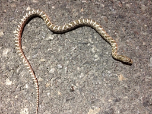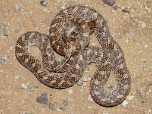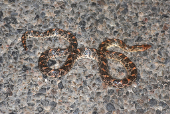Glossy Snake (Arizona elegans)
Description: The glossy snake and its many subspecies are all similar in appearance to gopher snakes. However, they are smaller than gopher snakes, with narrow, pointed heads, and a variety of skin patterns and colors. They appear "washed-out" or pale, hence the common name, "faded snakes".
Most subspecies are 30 to 50 inches in total length. The maximum recorded total length for the species is 56 inches.
They are shades of tan, brown, and gray with spotted patterns on their smooth, glossy skin, and a white or cream-colored unmarked ventral surface. Coloration often varies in relation to the color of the soil in a snake's native habitat.
Habitat: The varied habitats include barren to sparse shrubby desert, sagebrush flats, grassland, sandhills, coastal scrub, chaparral slopes, and sometimes oak-hickory woodland, generally in open areas with sandy or loamy soil, though rocks may be present.
Range: The species' range extends from central California, southern Nevada, southern Utah, southwestern and eastern Colorado, and southern Nebraska south through southern California, Arizona, New Mexico, Kansas, Oklahoma, and Texas in the United States, to northern Baja California, south to Sinaloa, Aguascalientes and Tamaulipas in Mexico. It occurs at elevations from below sea level in desert sinks to around 7,220 feet.
Diet: They are nonvenomous, nocturnal predators of small lizards.
Reproduction: Glossy snakes are oviparous. Adults breed in the late spring and early summer. Clutches average from 10 to 20 eggs. The eggs hatch in early summers and the newly hatched young are approximately 9.8 inches in total length.
Status: Listed as Least Concern in view of the large and probably relatively stable extent of occurrence, area of occupancy, number of subpopulations, and population size. This species is not threatened in most of its range.
»» Kingdom: Animalia - Animals
»» Phylum: Chordata - Chordates
»» Subphylum: Vertebrata - Vertebrates
»» Class: Reptilia - Reptiles
»» Order: Squamata - Scaled Reptiles
»» Suborder: Serpentes
»» Superfamily: Colubroidea
»» Family: Colubridae - Colubrids
»» Genus: Arizona
»» Species: Arizona elegans - Glossy Snake
This article uses material from the Wikipedia article "Glossy Snake", which is released under the Creative Commons Attribution-Share-Alike License 3.0. Content may have been omitted from the original, but no content has been changed or extended.
|













